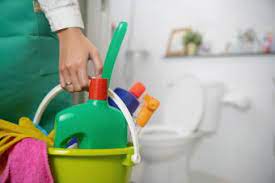Hotel Management Class Notes 29
How to Clean a Toilet the Right Way

No one flushes with excitement when it’s time to clean the toilet, but it’s an unavoidable task if you want to make sure your bathroom looks its best, as well as to keep bacteria from building up inside the bowl (and then spraying out into the rest of your bathroom with every flush).
It takes a bit more time and effort than a casual spray of Gatorade-colored cleaning fluid and a stir with a flimsy brush you grabbed at the corner store to get the porcelain sanitized and sparkling, but with the right tools and a few useful tips, it’s a task you can complete easily enough. Frequent cleaning greatly reduces the ick factor, too, so it’s a chore you should stay on top of.
What you need

- A toilet brush that’s not past its prime: A good toilet brush lets you get under the lip of the bowl to scrub out grime that you can’t see and covers a wide enough area that it won’t take forever to eliminate the grime on display. Also, make sure your toilet brush hasn’t lingered past its effectiveness: If the bristles are bent or the overall shape of the brush has warped, it’s time for a new one. You should replace a well-maintained and regularly cleaned brush (or brush head) about every six months.
- Bowl cleaner: A cleanser specifically made for toilet bowls will do the majority of the work to remove bacteria and hard-water buildup. The experts we talked to recommended any cleaner with some form of bleach, but you can find plenty of bleach alternatives, as well. I personally use Lysol Hydrogen Peroxide Toilet Bowl Cleaner.
- A bucket: To ensure that the entire bowl gets clean, you need to reduce the water level before applying the cleaner. This allows the disinfectant to do its work undiluted. To empty your bowl, quickly pour a half-gallon of water inside, which will trigger the flush action without the tank pouring any new water in to replace it.
- Surface disinfectant: The inside of your toilet isn’t the only part of the throne that you should clean regularly. Be sure to wipe down the outside of the bowl, the tank, the toilet seat, and especially the flushing handle. Also disinfect the toilet brush itself after using it. The experts we talked to recommend spraying the brush head with disinfectant, waiting about a minute, and rinsing it with hot water in your tub or shower. (Then, maybe, clean that area well.)
- Disinfectant wipes, a reusable rag, paper towels, or a sponge: Whatever tool you use to wipe down the exterior of a toilet, make sure it’s either washable, such as a reusable rag, or easily tossed, such as paper towels or disinfectant wipes. If you prefer a sponge, be sure to clean it thoroughly afterward, to separate it from other sponges when you store it, and to keep it dedicated to this one task. Some people may also prefer to use a good set of rubber gloves during this task, but I’ve always found them more cumbersome than helpful; I prefer to wash my hands thoroughly after I’m finished cleaning.
How long will it take to clean?
Depending on the brand of bowl cleaner you’re using, this project should take only about 15 to 20 minutes. Some cleansers’ instructions recommend letting the solution sit for up to 10 minutes, but you can work on wiping down the exterior parts of the toilet while you let the disinfectant do its job.

Get a really good toilet brush
There’s more to a toilet brush’s design than most people realize. Although the tool’s main job is to make cleaning your toilet easier—meaning, it has a head that’s shaped to reach all areas of the bowl and bristles that are firm enough to scrub but not flick toilet water (and … other things) everywhere—it should also be convenient and sanitary to store, and easily replaceable.
We like the OXO Good Grips Compact Toilet Brush and Canister. Its handle was comfortable for our testers, the replaceable brush head makes for consistent scrubbing performance, and the clever clamshell stand does a great job of hiding the brush away discreetly when you’re not using it.
Reduce the water level in the bowl
For the toilet bowl cleaner to do its work in sanitizing the porcelain, it needs to be undiluted, so you have to drain the water in the toilet. You have a few ways to accomplish this, but the easiest and quickest I’ve found is to fill a bucket or empty storage bin with about a half-gallon of water and quickly pour it into the toilet, aiming toward the back, where the water leaves the bowl. This step will trigger the flushing action and drain the water out without new water filling in from the tank.
Apply disinfectant to the inside of the bowl
Start at the top of the bowl under the rim and apply around the circle, letting the cleaner drain down the sides. Some cleaners come in bottles with an angled spout that makes this task a bit easier, but squeezing out the fluid still requires quite a bit of hand strength. If that’s an issue for you, aerosol sprays might make this step a bit easier. If you’re trying to get rid of more stubborn stains, let the disinfectant rest for up to 10 minutes.
Scrub thoroughly and rinse

When you’re done with the toilet brush, spritz the head with disinfecting spray, let it sit for a minute, and then rinse it with just hot water in the bathtub or shower. Also, be sure to spray down the toilet brush basin with your disinfectant to make sure nothing festers inside the nooks and crannies there.
Things to avoid
We don’t recommend using tank additives, those tablets or discs that can turn your toilet water so blue, it looks like a Smurf is slowly decomposing in your tank. These discs seem like an easy and maintenance-free option, as they’re designed to be dropped into the tank, where they dissolve over time, spreading disinfectant around the toilet bowl with every flush. But according to James Walsh, vice president of product management for toilet manufacturer American Standard, the reality is more complicated. “We do not recommend using in-tank cleaners because they will void your warranty,” he told us during an interview. “They will attack the working tank trim in the tank itself.” Basically, such tablets turn all the standing water in the tank into a caustic liquid, which can warp the rubber components required to keep the flushing mechanisms functioning. Over time this can lead to leaks and occasionally prevent the toilet from flushing entirely.
We also don’t recommend using disposable toilet-cleaning wands, which are an environmentally wasteful (and expensive) way to get the job done. In addition, we’ve found that toilet brushes with silicone bristles are too soft to scrub well.



